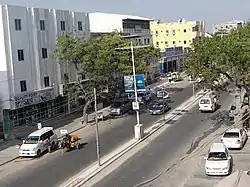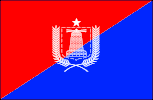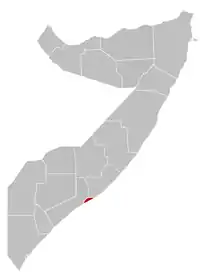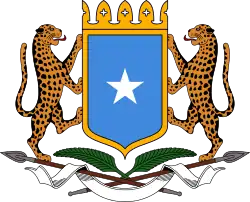Banaadir
Banaadir (Somali: Banaadir, Arabic: بنادر, Italian: Benadir) is an administrative region (gobol) in southeastern Somalia.[2] It covers the same area as the city of Mogadishu, which serves as the capital. It is bordered to the northwest by the Shabelle river, and to the southeast by the Indian Ocean.[3] Although by far the smallest administrative region in Somalia, it has the largest population, estimated at 3,650,227 (including 369,288 internally displaced persons) in 2014.[4]
Banadir State
Banadir | |
|---|---|
 Mogadishu street scene | |
 Flag  Coat of arms | |
 Location in Somalia | |
| Coordinates: 2°2′59″N 45°15′44″E | |
| Country | |
| Capital | Mogadishu |
| Government | |
| • Type | Federal |
| • Governor | Omar Mohamud Mohamed |
| Area | |
| • Total | 370 km2 (140 sq mi) |
| Population (2022) | |
| • Total | 5,500,280 |
| Time zone | UTC+3 (EAT) |
| HDI (2017) | 0.448[1] low · 1st |
The territorial extent and scope of the term Benadir has varied in definition throughout its history, with medieval usage extending Benadir to huge swaths of coast adjacent to Mogadishu stretching as far as hundreds of miles. The early modern period which extended the meaning of Benadir to the interior midway towards the Hirshabelle region, to the contemporary period wherein sometimes the nonstandard misnomer of usage being interchangeable with the city of Mogadishu. This Banaadir municipality is bordered to the north by Hirshabelle and to the southwest by South West, and is the only Somali gobol (administrative region) which is both a municipality and a gobol known as a region.
Overview
The Banaadir region is bordered by the Middle Shebelle (Shabeellaha Dhexe) and Lower Shebelle (Shabeellaha Hoose), as well as the Indian Ocean.
"Benaadir" is derived from the Somali banaadir, which means "coast", in reference to the southern Somali coastal cities of Mogadishu, Merka and Barawa. The place name reflects the region's medieval position as a key trade center with Persia, Arabian peninsula and the Swahili coast.[5]
Its capital is Mogadishu known as Xamar (pronounced: Hamar), although the administrative region itself is coextensive with the city. Benaadir is much smaller than the historical region of Benadir, which covers most of the country's central and southern seaboard opposite the Indian Ocean and up to the Juba River, including Mogadishu.
Thabit M. Abdi was appointed mayor of Mogadishu and governor of Banaadir in 2017, succeeding Yusuf Hussein Jimale who held that post since November 2015.[6]
Population
The 5,650,227(2021) residents of Benaadir are 50.7% female and come from 303,021 households.[4] It has the highest percentage of residents who are internally displaced persons among the regions of Somalia, because of its relative safety, economic opportunities and availability of resources.[4]
History
Political
Tradition and old records assert that southern Somalia, including the Mogadishu area, was historically inhabited by hunter-gatherers. These were later joined by Cushitic-speaking populations, who would go on to establish local aristocracies. During its medieval Golden Age, Mogadishu was ruled by the Muzaffar dynasty, and later by the Ajuran Sultanate. This is found mainly in Banaadiri oral tradition. It subsequently fell under the control of an assortment of local Sultanates and polities, most notably the Sultanate of the Geledi. The sultanate of the Geledi were in an alliance with the Zanzibar Dynasty. The city later became the capital of Italian Somaliland (1889–1936) in the colonial period. When the Italians arrived in Mogadishu the city had two towns only. These towns were Xamar Weyne and Shingaani. The people who lived in these towns were known as "reer xamar" who were the original population and the people that lived outside these towns, what is modern day Hodan, Boondhere and all the districts were known as Xamar Daye. These tribes mainly included Reer Mataan sub tribes. The Xamar Daye, being nomadic people used their lands as grazing lands and used them for things such as camel herding. They sold their cattle in bulk to the reer xamar merchants, who were urban dwellers and seafarers; they in turn traded these items throughout the Indian Ocean and brought back luxury goods such as ivory. After the Somali Republic became independent in 1960, Mogadishu became known and promoted as the White Pearl of the Indian Ocean. After the ousting of the Siad Barre regime in 1991 and the ensuing Somali Civil War, various militias fought for control of the city, later to be replaced by the Islamic Courts Union in the mid-2000s. The ICU thereafter splintered into more radical groups, notably the al-Shabaab, which fought the Transitional Federal Government (2004–2012) and its African Union Mission to Somalia allies. With a change in administration in late 2010, government troops and their military partners had succeeded in forcing out Al-Shabaab by August 2011. Mogadishu has then subsequently experienced a period of intense reconstruction.
Districts
The Banaadir region consists of seventeen districts.[7] Warta Nabada District was previously known as Wardhigley District until it was officially renamed in 2012.[8] Kahda District was formed in 2013 and is still absent from most maps.[9]
- Abdiaziz District
- Bondhere District
- Daynile District
- Dharkenley District
- Hamar-Jajab District
- Hamar-Weyne District
- Hodan District
- Howl-Wadag District
- Huriwa District
- Kaxda District[10]
- Karan District
- Shangani District
- Shibis District
- Waberi District
- Wadajir District
- Warta Nabada District
- Yaqshid District
References
- "Sub-national HDI - Area Database - Global Data Lab". hdi.globaldatalab.org. Retrieved 13 September 2018.
- "Somalia". The World Factbook. Langley, Virginia: Central Intelligence Agency. Retrieved 23 March 2015.
- Eno, Omar A., Mohamed A. Eno, and Dan Van Lehman. "Defining the problem in Somalia: perspectives from the southern minorities." Journal of the Anglo-Somali Society 47 (2010): 19-30.
- "Population Estimation Survey 2014 for the 18 Pre-War Regions of Somalia" (PDF). United Nations Population Fund. Retrieved 23 October 2016.
- Njoku, Raphael Chijioke (2013). The History of Somalia. ABC-CLIO. p. 69. ISBN 978-0313378577. Retrieved 14 September 2014.
- "Thabit Abdi named as the new Mayor of Mogadishu". Hiiraan Online. 6 April 2017. Retrieved 11 July 2019.
- Districts of Somalia
- Somali president renames Mogadishu district to foster peace, SabahiOnline.com, 10 April 2012. Accessed on 23 October 2016.
- See: "Somali Voices" Radio Program Connects Families, Fosters Dialogue on Tough Issues Archived 2016-04-16 at the Wayback Machine, Internews, 27 February 2014. Accessed on 7 October 2015.
- so:Kaxda
